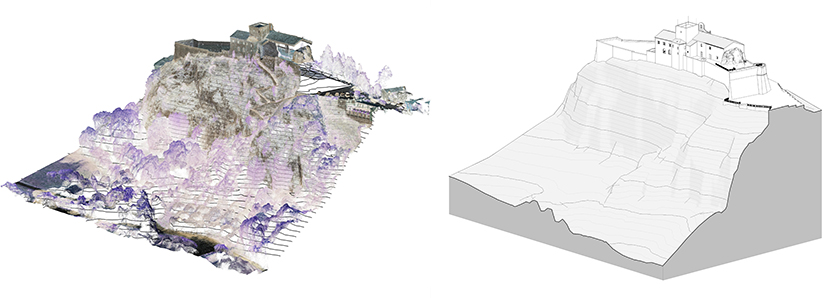
The Rocca Malatestiana of Verucchio. SCAN to HBIM process for the digitisation of cultural site with severe topography condition
Abstract
The essay highlights the process of three-dimensional acquisition and digitisation through HBIM of the Rocca Malatestiana of Verucchio, in the Rimini area. The case study presented is set in a context strategically located on a hill overlooking the Marecchia river valley with high orographic and interpretative difficulties due to the different overlapping historical layers. The Malatesta Fortress of Verucchio, which is built on a number of levels to accommodate the terrain’s orography, is perched atop the towering pinnacle of a rocky spur that dominates the Marecchia valley. Due to its location nearly 300 meters above sea level, overlooking the Adriatic Sea and the Apennines, the fortress—a symbol of the Malatesta family’s power—became a crucial strategic and defensive hub. It served as the main seat of Malatesta power along the coast and in the Marche region for centuries.
The research group involved in the project of integrated three-dimensional survey and digitisation through BIM of the building of the Rocca di Verucchio has worked to give back to the small municipality a model for the management of the rich heritage of the place.
The integrated scanning and HBIM implementation process has resulted in a coherent and highly informative digital model of the material, historical and typological conformation of the various parts of the artefact. The Verucchio case study exemplifies how the development of digital representation systems for architectural heritage is a field that is constantly evolving and is currently a focus of interest and innovation for all players in the field.
DOI: https://doi.org/10.20365/disegnarecon.31.2023.2
Keywords
Full Text:
PDFReferences
Balzani, M. (2016). Il rilievo tridimensionale dell’Istituto degli Innocenti. in Mulazzani, M. L’Ospedale degli Innocenti di Firenze: la fabbrica brunelleschiana, gli Innocenti dal Quattrocento al Novecento, il nuovo museo: il progetto di recupero e l’allestimento di Ipostudio (pp. 63-69). Milano: Electa.
Balzani, M., Maietti, F. (2017). Architectural Space in a Protocol for an Integrated 3D Survey aimed at the Documentation, Representation and Conservation of Cultural Heritage. Diségno, (1), 113–122.
Barba, S., Parrinello, S. Limongiello, M., Dell’Amico, A. (2020). D-SITE, Drones – Systems of Information on culTural hEritage. For a spatial and social investigation. Pavia: Pavia University Press.
Berardi D., Cassi Ramelli A., Foschi M., Montevecchi F., Ravaldini G., Venturi S., (1970). Rocche e castelli di Romagna. Bologna: Edizioni Alfa.
Bernardi, L. (2004). Verucchio, guida storico-artistica illustrata. Rimini: Pazzini Editore.
Bianchini C., Inglese C., Ippolito A. (2016). Il contributo della Rappresentazione nel Building Information Modeling (BIM) per la gestione del costruito. DISEGNARE CON, 9(16), 10.1-10.9.
Bianchini C., Nicastro S. (2018). La definizione del Level of Reliability: un contributo alla trasparenza dei processi di Historic-BIM. «Dn», 2/2018, 46-60.
Brusaporci, S., Maiezza, P., & Tata, A. (2018). A framework for architectural heritage HBIM semantization and development. International Archives of the Photogrammetry, Remote Sensing & Spatial Information Sciences, 42(2).
Giuccioli, M.G. (1996). Guida alla Rocca Malatestiana di Verucchio. Rimini: Pazzini Editore
Grilli, E., Menna, F., and Remondino, F. (2017). A Review of Point Clouds Segmentation and Classification Algorithms. International Archives of the Photogrammetry, Remote Sensing & Spatial Information Sciences, XLII-2/W3, 339–344.
Larner J., (1972). Signorie di Romagna. La società romagnola e l’origine delle signorie. Bologna: Il Mulino Editore.
Malinverni, E. S., Mariano, F., Di Stefano, F., Petetta, L., Onori, F. (2019). Modelling in HBIM to document materials decay by a thematic mapping to manage the cultural heritage: the case of “Chiesa della Pietà” in Fermo. The International Archives of the Photogrammetry, Remote Sensing and Spatial Information Sciences, Volume XLII-2/W11, 777-784.
Mascanzoni, L. (2003). Le grandi fasi storiche fra XII e XV secolo nello specchio dei rapporti Verucchio-Rimini. Studi romagnoli 54(2003), 17-31.
Von Eles, P. (1998). Museo Civico Archeologico. Rimini: catalogo museale.
Pecci G., (1962). Verucchio e la sua Rocca. Guida storico-turistica. Verucchio: catalogo museale.
Pasini, P. G. (2013). Itinerari Malatestiani: a Rimini e nel Riminese. Rimini: Guaraldi Editore, 1-173.
Raco, F. Rizzi, D., Giau, G., Galvani, G., (2020). Rilievo e rappresentazione del costruito esistente per l’HBIM. Digital documentation and Historic Building Information Modeling. Paesaggio Urbano. 3/2020, 132-145.
Rimondini G., (1989). Rocche, tombe e castelli, in Maricla. 8 lezioni per conoscere il fiume Marecchia e la sua valle. Rimini: Maggioli editore.
Rodriguez-Navarro P. (ed.) (2017). Archaeological Drawing. Disegnarecon, 10(19).
Saygi, G., & Remondino, F. (2013). Management of Architectural Heritage Information in BIM and GIS: State-of-the-Art and Future Perspectives. International Journal of Heritage in the Digital Era, 2(4), 695–713.
Spallone, R. e Piano, A. e Piano, S. (2016). B.I.M. e beni architettonici: analisi e rappresentazione multiscalare e multidimensionale di un insediamento storico. Il caso studio di Montemagno, Borgo Nuovo piemontese. Disegnarecon 16(2016), 1-13.
Suppa, M. (2022). Optimisation of survey procedures and application of integrated digital tools for seismic risk mitigation of cultural heritage. The Emilia-Romagna damaged theatres. (Doctoral dissertation). University od Ferrara, Italy.
Turchini, A. Orioli, M., Viroli, M., Novara, P. Castellari, C., (2017). La Romagna dei castelli e delle rocche. Cesena: Società editrice Il Ponte Vecchio.
Zerlenga, O., Corniello, L., Cirillo, V., Palmieri, A., De Cicco, A., Lento, G. P., Mqliqari, A. (2023). The architectural heritage of Berat in Albania. Photogrammetric survey, 3d laser scanner and digital modelling. In Balzani, M., Bertocci, S., Maietti, F., Rossato, L. (Eds.), Research Innovation and Internationalisation. National and international experiences in Cultural Heritage digitisation. (pp. 53-64). Rimini: Maggioli editore.
Refbacks
- There are currently no refbacks.
Copyright (c) 2023 Luca Rossato, Fabio Planu, Greta Montanari
DISEGNARECON
ISSN 1828 5961
Registration at L'Aquila Law Court no 3/15 on 29th June, 2015.
Indexed in SCOPUS. Diamond Open Access. All papers are subjected to double blind peer review process by qualified reviewers.
Journal founded by Roberto Mingucci
